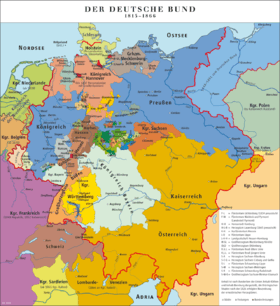Lesser Germany
The term Lesser Germany (German: Kleindeutschland, in opposition to 'Greater Germany') relates essentially to Germany without Austria. In the 19th century, a part of the Austrian Empire belonged to the German Confederation. In the revolutionary era of 1848–1850, it was discussed whether Austria or a part of Austria could belong to a new German federal state. In 1867–1871, the 'Lesser Germany' became reality: a federal state under leadership of Prussia and without Austria. After that, the term lost its significance because since then 'Germany' is usually identified as this Lesser Germany.
The other term, Greater Germany, remained in use for those who sought to incorporate Austria or the German-speaking parts of Austria into Germany. This became a political issue in the aftermath of World War One and then again in 1938–1945. During the Cold War, when Germany was divided, a unified Germany was called 'Gesamtdeutschland'.
Evolution in the revolutionary era

Since 1815, the German states had belonged to the German Confederation. Its territory was defined essentially after the Holy Roman Empire. Some member states belonged to the confederation only with a part of their territories, such as Prussia and especially Austria. The territory within the confederation was called bundeszugehörig (belonging to the confederation), the other bundesfremd (foreign to the confederation). Only Bundesgebiet (federal territory = territory within the boundaries of the confederation) was protected by the military provisions of the German Confederation.
In March 1848, revolution broke out in Germany and other European countries. The Federal Assembly, the only organ of the German Confederation, elected a National Assembly to work out a constitution for a German federal state. The German National Assembly also installed a provisional head of state (the uncle of the Austrian Emperor) and government. Initially, it was universally accepted that the federal territory of Austria should be a part of the new German state.
During the course of 1848, it became evident that the Austrian government was not willing to live with the consequences of a German federal state. The German National Assembly refused to accept all of Austria, as this would have burdened the new state with the nationality conflicts of Austria. Only the part of Austria that was already federal territory was welcome, even if it included a large ethnic minority (the Czechs). The rest of Austria had to be separate in terms of constitution, government and administration. The Austrian Emperor would be head of state of both parts in a personal union.
Austria refused this division of its imperial territory: It was afraid that the personal union was insufficient to keep the parts of Austria together. In March 1849, the Austrian Emperor issued a new Austrian constitution which defined Austria as a centralist state. By then, the German National Assembly was already divided in 'Greater Germans' (often Catholics) and 'Lesser Germans'. The latter tendency became in March 1849 the majority.[1] It voted for a German constitution that left open the accession of Austria, but elected the Prussian king to be German Emperor.
The Prussian king refused to accept the imperial crown in April. But immediately, he tried to unify Germany by himself with a project that was later called 'Erfurt Union'. Austria was not supposed to become part of this version of Lesser Germany. Joseph von Radowitz, adviser to the Prussian king and actual leader of the project, tried to bind Austria and the Union together in a confederation. Austria rejected these attempts and made Prussia give up its union plans in late 1850.
Evolution after 1850
-en.png)
Austria remained a part of the re-established German Confederation, while Prussia still tried to improve its position within the confederation and even cherished its union plans. Around 1860, the German question became dynamic again. Austria came out weakened by the Italian War of the previous year while Prussia sought to gain the approval of the national movement. Several proposals were made to reform the German Confederation, most notably in 1863 at the Frankfurter Fürstentag. At this moment, the networks of the political elites in Lesser Germany were already quite separate from the Austrian ones.
In April and June 1866, Prussia proposed to convert the German Confederation into a federal state without Austria. Bavaria refused to become Prussia's junior partner in this project. But nevertheless Prussia sought the confrontation with Austria that was unwilling to accept Prussia as its equal within the confederation. The Austro-Prussian War of summer 1866 ended with a Prussian victory and the dissolution of the German Confederation.
Prussia established a federal state in Northern Germany, called the North German Confederation. In the peace treaty with Austria, and already before with France, Prussia promised not to expand the North German state to southern Germany.
Austria still tried to be a player in the German question. In summer 1870, war broke out between France and the North German Confederation. The south German states were loyal to their military conventions with the North. Austria did not dare to support France because of its weak position after the war of 1866 and because of the German-speaking inhabitants sympathizing with the German cause. Finally, the Austrian government accepted the evolution and the creation of a Lesser Germany in December 1870.[2]
Footnotes
- Wolfram Siemann: Die deutsche Revolution von 1848/49. Suhrkamp Verlag, Frankfurt 1985, pp. 195-197.
- Michael Kotulla: Deutsche Verfassungsgeschichte. Vom Alten Reich bis Weimar (1495–1934). Springer, Berlin 2008, p. 527.